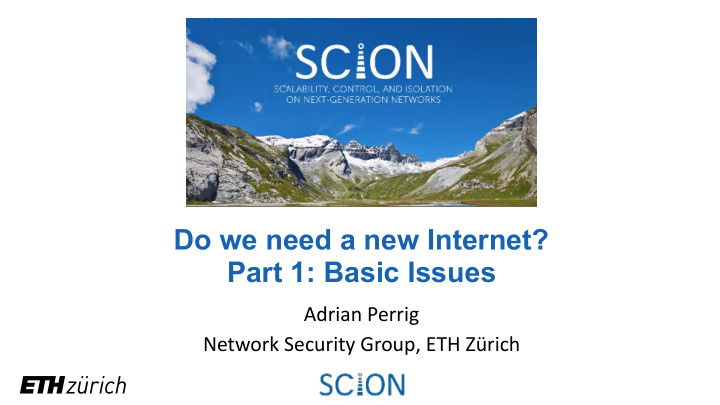



Do we need a new Internet? Part 1: Basic Issues Adrian Perrig Network Security Group, ETH Zürich
Imagine a building or structure that represents the Internet
The Internet … The Internet is perceived to be like the pyramids: monumental structure that has stood the test of time and cannot be changed … an ancient structure … … that appears stable and seems unchangeable 3
More like today’s Internet … Transparency Availability Control Secure E2E Comm 4
Problem 1: Availability Transparency Availability Control Secure E2E Comm 5
Poor Availability ▪ Well-connected entity: 99.9% availability (86 s/day unavailability) [Katz-Bassett et al., Sigcomm 2012] ▪ Plug-into-the wall telephones: 99.999% availability (0.86 s/day unavailability)! ▪ Numerous short-lived outages due to Border Gateway Protocol (BGP) route changes and route convergence delays ▪ Outages due to misconfigurations ▪ Outages due to attacks ▪ E.g., prefix hijacking, DDoS 6
Problem 2: Control Transparency Control Secure E2E Comm 7
Who controls Internet Paths? ▪ Current Internet offers limited control of paths ▪ Paths can be hijacked and redirected 8
Limited Path Control in BGP ▪ Current Internet offers limited control of paths • Border Gateway Protocol (BGP) floods announcements for destinations • No inbound traffic control 9
Who should control Paths? ▪ Clearly, ISPs need some amount of path control to enact their policies ▪ How much path control should end domains and end points (sender and receiver) have? • Control is a tricky issue … how to empower end points without providing too much control? No Limited Complete Endpoint Endpoint Endpoint Control Control Control 10
Problems due to Lack of Path Control ▪ Limited traffic load balancing for sender and receiver ▪ No multi-path communication ▪ No optimization of networking paths for sender and receiver ▪ Poor availability ▪ Outages cannot be circumvented ▪ Connection can suddenly break ▪ Traffic redirection attacks become possible 11
Problem 3: Transparency Transparency Secure E2E Comm 12
Transparency ▪ Path transparency • Today, sender cannot obtain guarantee that packet will travel along intended path • Impossible to gain assurance of packet path ▪ Because router forwarding state can be different from routing messages received ▪ Trust transparency • Today, we cannot enumerate trust roots we rely upon 13
Problem 4: Secure E2E Communication Secure E2E Comm 14
Fake Certificates lead to Attack ▪ Adversary misuses fake certificate to impersonate one party to the other (man-in-the-middle attack) Alice Mallory Bob 15
Problems with SSL / TLS Certificates ▪ Famous case: false Microsoft ActiveX certificate issued by Verisign in January 2001 ▪ VeriSign Hacked, Successfully and Repeatedly, in 2010 VeriSign attacks were revealed in a quarterly U.S. Securities and Exchange Commission filing in October • 2011 ▪ March 2011: Attack on Commodo reseller, several fraudulent certificates were issued: mail.google.com, www.google.com, login.yahoo.com, login.skype.com, addons.mozilla.org, login.live.com Suggested that attack originated from Iranian IP address • http://www.comodo.com/Comodo-Fraud-Incident-2011-03-23.html • ▪ August 29, 2011: news broke that DigiNotar, a Dutch CA, improperly issued a certificate for all Google domains to an external party Claim: 250 certificates for an unknown number of domains were released • Iranian government spied on Iranian citizens' communications with Google email during the month of • August 2011 ▪ Stuxnet used compromised certificates from 2 Taiwanese CAs 16
Non-Scalability of Trust ▪ As the Internet has grown to encompass a large part of the global population, trust relationships have become heterogeneous: no single entity trusted by everyone • Complicates construction of entity authentication infrastructures ▪ Current Internet authentication infrastructures have weak security properties • Single points of failure • Security of the weakest link 17
Summary: Which Problems Should we Address? ▪ High availability: enable end-to-end connectivity despite network disruptions ▪ Path control: ISP, sender, and receiver, jointly control end-to-end paths ▪ Transparency • Path transparency: sender should be aware of packet’s path • Trust transparency: known roots of trust that need to be relied upon ▪ Resilience to compromised trust roots: limit global scope of certification authorities 18
For More Information … ▪ … please see our web page: www.scion-architecture.net ▪ Chapter 1 of our book “SCION: A secure Internet Architecture” ▪ Available from Springer this Summer 2017 ▪ PDF available on our web site ▪ Part 2 of this presentation: “Motivations for Change” 19
Recommend
More recommend